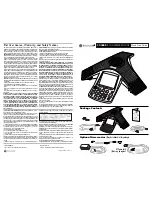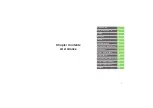
GX20
2 – 72
CONFIDENTIAL
*
1: The LED test is also available in the manual test mode F45.
<Startup>
1. Fit a battery in the set to start the manual test mode.
2. Press the keys “4”
→
“5”
→
“Right Soft” to start the manual test mode F45 (LED Setting).
3. Press the following keys for ON/OFF operation.
4. Press the "Centre" key twice to return to the initial screen of the manual test mode.
5. Press the “End/Power” key to finish operation.
*
2: Only when performing the TMPAD4 command or turning power OFF/ON, A/D adjusted values are reflected in temperature.
*
3: The IrDA test is also available in the manual test mode F13.
<Startup in the jig mode>
Provide a set other than the tested set, which has been confirmed to operate normally. Use this set as the IrDA receiver.
1. Fit a battery in the set to start the manual test mode.
2. Press the keys, “1”
→
“3”
→
“Right Soft” to start the manual test mode F13 (IrDA Test).
3. Press the key “Left Soft” (S1: Test Device Mode).
* The infinite loop mode for the IrDA data stand-by is started. After finishing the test, remove the battery.
<Startup in the test mode>
Data are transmitted/received by using the tested set.
1. Fit a battery in the set to start the manual test mode.
2. Press the keys, “1”
→
“3”
→
“Right Soft”, to start the manual test mode F13 (IrDA Test).
3. Direct the IrDA window of the tested set to that of the jig set.
4. Press the key “0” (0: Check IrDA) to transmit data automatically.
5. When “OK” is displayed, transmitting/receiving is normally completed. When “NG No Data” is displayed, transmitting/receiving is
abnormally ended.
6. Press the "Centre" key twice to return to the initial screen of the manual test mode.
7. Press the “End/Power” key to finish operation.
*
4: The melody playback test is also available in the manual test mode F51.
<Startup>
1. Fit a battery in the set to start the manual test mode.
2. Press the keys, “5”
→
“1”
→
“Right Soft”, to start the manual test mode F51 (Melody Test).
3. Press the following keys to switch operations.
Key
Description
Contents
“0”
OFF
All LEDs OFF
“1”
Charge LED ON/OFF
Charge LED (Also used as the strobe light: RED)
“2”
Incoming call LED ON/OFF
MA2 LED (Also used as the strobe light: GREEN)
“3”
Key LED ON/OFF
Key LED (LED301 to LED316: GREEN)
“4”
Main display back light ON/OFF
Main display back light (Back light FPC: WHITE) *a
“5”
External display back light ON/OFF
External display back light (LED401, 402: WHITE)
“6”
Changing the strobe light color
Changing the strobe LED color (7 colors) *b
“7”
Changing full output time of strobe light
Changing full output time of strobe LED *c
“
”
Strobe light ON with full output
Lighting the strobe LED with full output for the setting time as
specified in "7" above.
“#”
Changing flash mode
Changing brightness according to flash modes *d
“Centre”
End
Shifting from this mode to the initial screen
* a : Every time a key is pressed, the operation, “Stanb-by
→
Brightness 1
→
2
→
3
→
4
→
OFF”, is repeated.
* b : With every pressing of the key, color changes repeatedly in the order of "Blue
→
Green
→
Light Blue
→
Red
→
Purple
→
Yellow
→
White"
* c : With every pressing of the key, setting time changes repeatedly in the order of "400ms
→
800ms
→
300ms".
* d : With every pressing of the key, flash mode changes repeatedly in the order of "Macro pre-flash
→
Normal pre-flash
→
Spot light
→
OFF".
Key
Description
Contents
“
”
Selecting melody tone.Select the next melody by toggling.
If the final melody is selected, further selection is unavailable.
“
”
Selecting melody tone.Select the preceding melody by toggling.
If the default melody is selected, further selection is unavail-
able.
“0”
Ring tone playback.
Playback/Stop.
Toggle the selected ring tone between playback and stop.
Default: –16 dB
0: Stop 1: Playback
“Right
Soft”
Key touch tone output.Toggle the key touch tone between ON and OFF.
0: Stop 1: Output (DTMF: –16dB)
















































